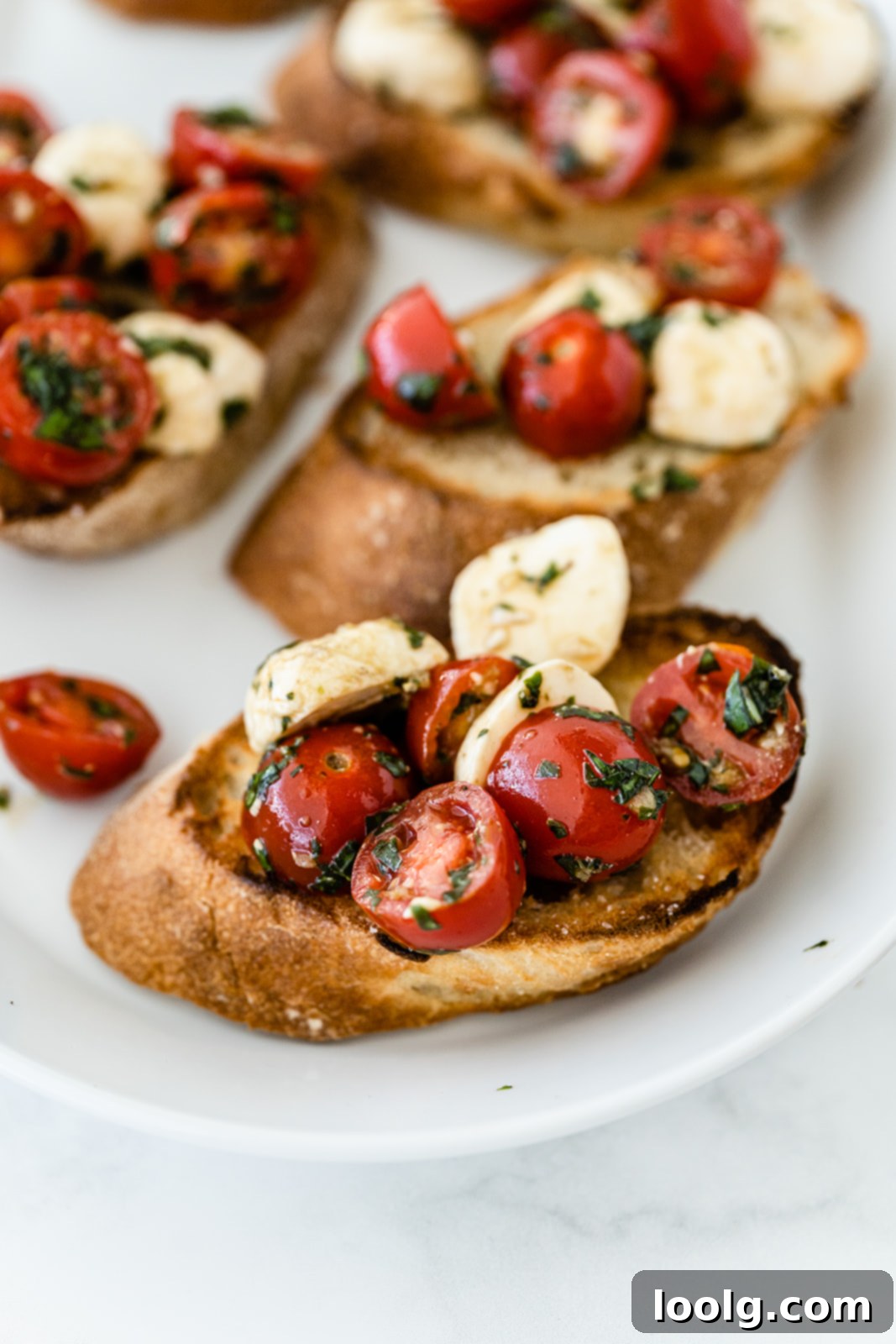Delicious Mozzarella Bruschetta: An Easy, Flavor-Packed Italian Appetizer
This mozzarella bruschetta is incredibly simple yet bursts with incredible flavor. It’s a versatile dish that can be effortlessly prepared in the oven or on the grill, making it perfect for any occasion. Furthermore, it’s remarkably easy to adapt for various dietary needs, including gluten-free, vegan, and paleo lifestyles, ensuring everyone can enjoy this delightful treat.
When it comes to enjoying the peak freshness of ripe tomatoes, this mozzarella bruschetta recipe, alongside our Italian Tomato Salad, stands out as our absolute favorite. If we ever find ourselves with an abundance of tomatoes after a great sale, this is always our go-to solution. It transforms a simple harvest into a truly memorable dish.
What makes this recipe so beloved is its perfect balance of speed, ease, and profound satisfaction. It’s particularly fantastic when you have the grill fired up, imparting a smoky depth to the bread that elevates the entire experience. While we often opt for the oven due to its frequent use in our kitchen, there’s no denying that grilled bruschetta offers an unparalleled taste and texture. The char marks and smoky essence from the grill add a rustic charm that’s hard to beat.
This particular rendition of bruschetta could also accurately be described as Caprese bruschetta, given its generous use of creamy mozzarella, vibrant fresh basil, and juicy tomatoes. It captures the essence of the classic Caprese salad, transforming it into a delightful bite-sized appetizer.
For those curious about tradition, authentic Italian bruschetta typically features just a few core ingredients: olive oil, toasted bread, fresh garlic, ripe tomatoes, basil, and a sprinkle of salt. The exact composition can vary slightly from one Italian region to another. For instance, Sicilian bruschetta might introduce oregano into the mix instead of basil, showcasing the rich diversity of Italian culinary traditions.
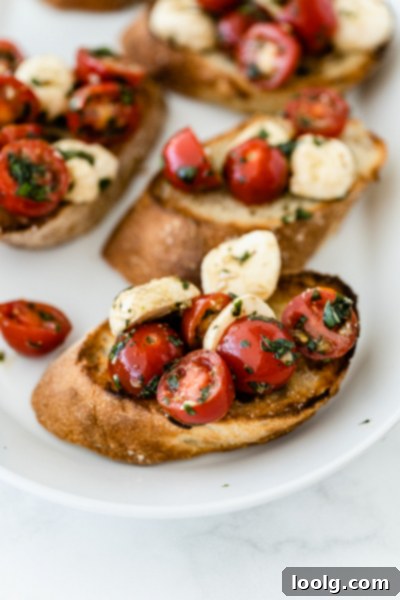
In our adapted recipe, we’ve intentionally included two additional ingredients: luscious mozzarella and a touch of balsamic vinegar, along with freshly ground black pepper. As I’ve mentioned in my post about Italian tomato salad, black pepper is not a staple in much of traditional Italian cooking. However, after extensive experimentation, we found that adding a dash of black pepper to this bruschetta significantly enhances its overall flavor profile. We conducted taste tests with and without it, and the version with black pepper consistently won us over. While we humbly apologize to any Italian culinary purists who might find this unconventional, we believe the added zing is well worth it! We hope you’ll agree that it doesn’t “butcher” the essence of bruschetta, but rather complements it beautifully.
Preventing Soggy Bruschetta: Essential Tips for a Perfect Crunch
One common pitfall when making bruschetta is ending up with soggy bread, which can certainly detract from the enjoyment of this otherwise crisp and fresh appetizer. We encountered this challenge ourselves during our initial attempts at making this dish. Fortunately, we’ve developed a few tried-and-true tips to help you achieve perfectly crisp bruschetta every single time.
If you opt for cherry tomatoes, as pictured in many of our photos, it’s crucial to pat them thoroughly dry after slicing them. Cherry tomatoes hold a surprising amount of water, and skipping this simple step can easily lead to a wet topping that saturates your toasted bread. A few moments spent with a paper towel can make all the difference, ensuring your bruschetta remains delightfully crisp.
For any other type of tomato—be it beefsteak, heirloom, or larger varieties—you’ll absolutely want to take the extra step of deseeding them. We learned this the hard way: our first few batches of bruschetta made without deseeding larger tomatoes consistently resulted in a watery, messy topping that simply didn’t hold up. Initially, the idea of deseeding tomatoes seemed like an unnecessary chore. I distinctly remember scoffing at my husband when he suggested it, thinking it was utterly absurd and too much effort for a simple appetizer. 😂
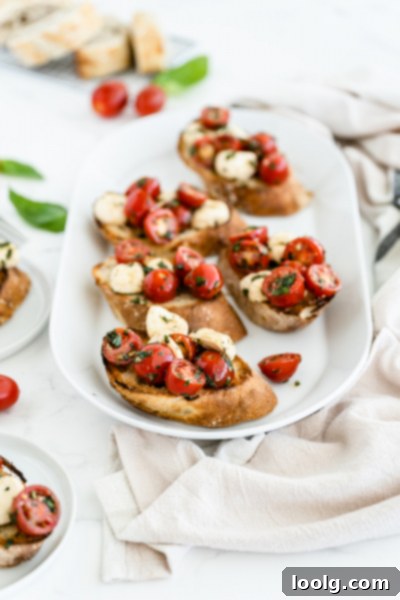
However, I quickly discovered that deseeding tomatoes truly takes only a minute or two of your time. This small investment is incredibly worthwhile, as it’s the key to preventing that dreaded soggy bruschetta. The difference in texture and enjoyment is remarkable, making it a step we now never skip.
Before we fully embraced the deseeding technique, I mistakenly believed that omitting the olive oil from the tomato mixture might help combat sogginess, reasoning that it was just another liquid contributing to the problem. While this seemed logical at the time, it proved to be a significant error. Don’t make this mistake!
That single teaspoon of olive oil in the tomato mixture plays a vital role, binding the flavors and providing a necessary richness. Our reaction after trying it without oil was essentially, “Oh nooo. This is all kinds of wrong.” It highlighted just how crucial each ingredient is to the overall balance and deliciousness of the bruschetta.
Choosing the Best Ingredients for Unforgettable Bruschetta
The quality of your ingredients directly impacts the success of your bruschetta. This dish celebrates fresh flavors, so choosing the best possible components is paramount.
Perfecting the Tomato Selection
For the most vibrant and flavorful bruschetta, you absolutely must use really good, perfectly ripe tomatoes. Whether you choose juicy beefsteak, flavorful heirloom, sweet cherry, or firm plum tomatoes, all can yield excellent results. The key is ripeness—they should be fragrant, slightly soft to the touch, and bursting with natural sweetness. While some recipes suggest blanching tomatoes to remove their skins, we’ve found this step to be entirely unnecessary for bruschetta. It adds extra time and effort to the preparation without yielding any noticeable improvement in taste or texture. Plus, who wants to heat up their kitchen even more during the summer months when tomatoes are at their prime?
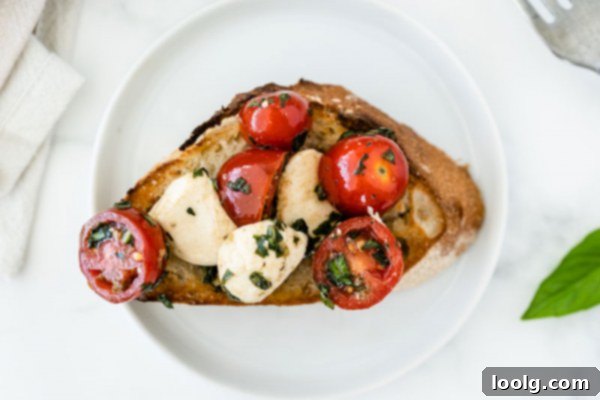
The Art of Salting and Garlic Application
Beyond the tomato mixture, how you treat your bread is equally important. Unless your bread already has a noticeably salty crust, we highly recommend salting the bread lightly after you brush it with olive oil. This might sound a bit unconventional, but that small, extra sprinkle of salt truly makes a huge difference, enhancing the flavors of both the bread and the topping. Again, apologies to any Italian friends who might find this practice unusual, but we believe it adds a crucial layer of taste.
Our bruschetta recipe with mozzarella tends to be a bit more garlicky than many other versions you might encounter, and for good reason! We experimented with various garlic application methods: using minced cooked garlic, raw minced garlic, and the traditional fettunta method of rubbing raw garlic cloves directly onto the toasted bread pieces. The fettunta approach is historically authentic, but in our experience, perhaps due to the age of our garlic, the type of bread, or the thickness of our slices, it didn’t quite deliver the intense garlic flavor we were looking for. Surprisingly, both of us preferred the raw minced garlic the most. It provides a sharp, fresh garlic kick that truly shines in this dish, and as an added bonus, it requires less work than cooking the garlic!
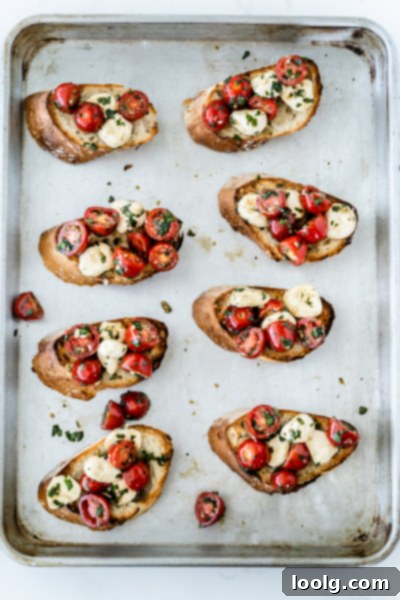
Choosing the Perfect Bread
Speaking of bread, not just any loaf will do for bruschetta. The foundation of great bruschetta is a sturdy, crusty loaf. A good artisan or rustic bread works exceptionally well, providing the ideal texture that crisps up beautifully without becoming too hard. It’s also important to select a loaf without overly large holes, as you don’t want your delicious topping to fall through, creating a messy eating experience.
Mastering the Mozzarella
We love to load this bruschetta with halved mini mozzarella balls, often called “bocconcini” or “ciliegine,” for their delightful texture and creamy flavor. If these aren’t readily available, don’t worry—you can use any fresh mozzarella you prefer. However, we’ve found that in Germany, where we live, the mini mozzarella balls are significantly more flavorful than the larger fresh mozzarella balls, which can often taste quite bland and be excessively wet. If you do opt for larger fresh mozzarella, we strongly recommend cutting it into pieces, salting them lightly, and then letting them drain on paper towels for about 10 minutes. Afterward, use more paper towels to thoroughly pat them dry. This crucial step removes excess moisture, preventing your bruschetta from becoming soggy and ensuring a richer, more concentrated mozzarella flavor.
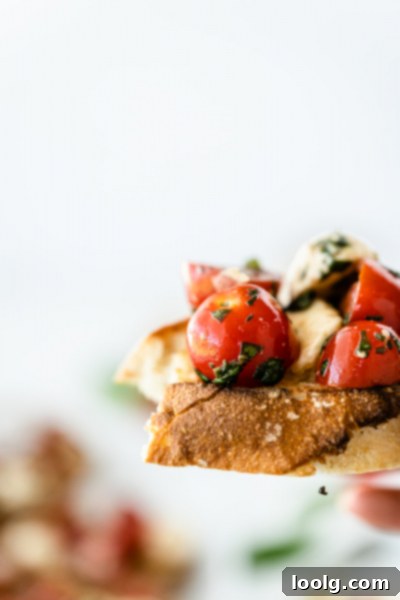
For those who prefer a different cheesy touch, you can certainly use a sprinkle of Parmesan or Pecorino Romano instead of mozzarella. And for an equally delicious, lighter option, this bruschetta is fantastic even without any cheese at all! In fact, we often prepare it this way, especially when we don’t have the right kind of fresh mozzarella on hand. When made without cheese, it automatically becomes paleo and vegan-friendly (provided you select an appropriate type of bread).
Balsamic Vinegar: A Splash of Sweet Tang
Balsamic vinegar adds a wonderful depth and tang to this bruschetta. For truly exceptional flavor, traditional balsamic vinegar (Aceto Balsamico Tradizionale DOP / PDO) is unparalleled, but it is incredibly expensive and primarily found in Italian specialty stores or online. However, we’ve found that using the more common “Balsamic Vinegar of Modena” (Aceto Balsamico di Modena IGP/PGI) from the grocery store yields fantastic results for this recipe, and we absolutely love it. You don’t need a tiny 100ml (3.4oz) $65 bottle to make delicious bruschetta, and we don’t think you do either. Just be sure to choose a good quality balsamic that doesn’t contain nasty additives or artificial flavorings. You’ll definitely want to avoid any imitation balsamic vinegars, as they lack the authentic flavor profile. As an alternative, red or white wine vinegar can also be used; we recommend starting with 1/2 tablespoon, tasting, and adding more if desired.
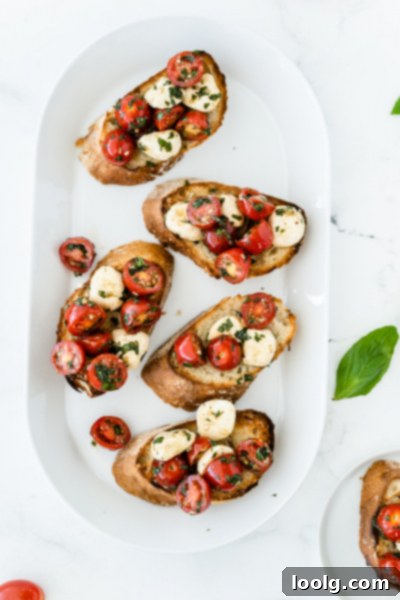
Dietary Adaptations: Enjoy Bruschetta Your Way
One of the best aspects of this bruschetta recipe is its adaptability to various dietary needs. Craving gluten-free bruschetta? Simply use your favorite gluten-free bread. Just double-check that your balsamic vinegar is also gluten-free, as some commercial varieties can contain hidden gluten. Traditional balsamic vinegar is naturally gluten-free, but standard grocery store balsamic vinegar of Modena may or may not be. For homemade gluten-free bread, you might consider trying this excellent gluten-free artisan loaf. For paleo enthusiasts, this paleo crusty bread is an excellent option. And if you’re looking for a vegan version, this vegan artisan bread works wonderfully, coupled with omitting the mozzarella.
We truly hope you give this mozzarella bruschetta a try! It’s a versatile, flavor-packed appetizer that’s perfect for entertaining or a simple, delicious snack. If you do, we’d absolutely love to hear what you think of it!
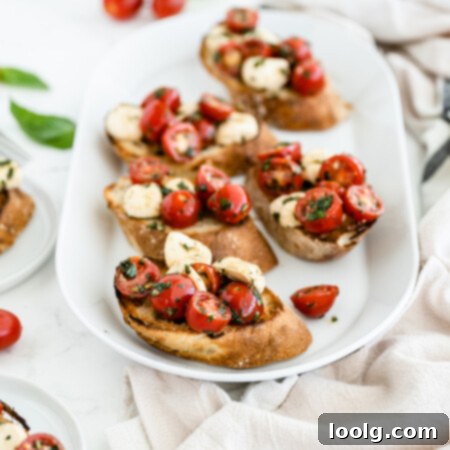
Mozzarella Bruschetta
Ingredients
- 24 basil leaves chopped
- 1 tablespoon minced garlic
- 1/4 salt + extra for salting the bread
- 1/4 teaspoon freshly ground black pepper
- 1 teaspoon olive oil for the tomatoes + another 2-4 tablespoons for brushing on bread
- 1 tablespoon balsamic vinegar (or 1/2 up to 1 tablespoon red or white wine vinegar)
- 1 1/2 cups halved cherry tomatoes – patted dry to help reduce the water
- 8 ounces halved small fresh mozzarella balls (omit for paleo / vegan)
- 1/2 of a crusty loaf of rustic / artisan style bread (you need eight 1/2″ pieces – depending on your loaf size, you may need more or less. You’ll have enough tomato mixture for 3 tablespoons per slice) make sure to use gluten-free, vegan or paleo bread, if needed
Instructions
-
Cut the loaf into eight 1/2″ pieces. Turn on the broiler. You can alternatively grill the bread. See below for instructions.
-
While it’s heating up, make the tomato mixture. In a medium bowl, mix together the basil, garlic, 1/4 teaspoon salt, pepper, 1 teaspoon olive oil, and balsamic vinegar. Once combined, add the tomatoes and halved mozzarella balls. Set aside, while prepring the bread, but not for too long – it gets watery. It’s good to let it sit for 10-15 minutes for the flavors to meld but I don’t recommend letting it sit much longer.
-
Pour 2 tablespoon of olive oil in a little bowl and brush the bread with olive oil (if grilling, oil both sides). Use more oil, if needed. Sprinkle the tops of the bread slices with a little salt. Place the bread under the broiler. You’ll need 2–4 minutes, or until the edges are golden brown and the tops feel crisp to the touch.
-
If grilling, grill the bread slices over indirect heat, on both sides, until golden brown. Remove from the grill.
-
Remove from the oven / grill and top with the tomato mixture. Serve immediately.
